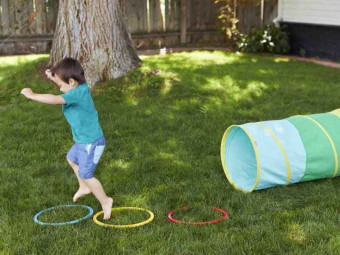Raspberry Pi Essentials
Tags: Raspberry Pi
Learn Raspberry Pi4 for beginners! Start from the basics and go all the way to build your own Projects
Last updated 2022-01-10 | 4.5
- Learn how to setup Raspberry Pi3/4 and write python programs- Build several Raspberry Pi based Mini Projects to get more inside
- Get hands-on experience of working with Linux and Python Programming
What you'll learn
* Requirements
* Raspberry Pi3/4 Model B/B+* Computer with installed Windows OS
* You can create a small circuit with breadboard
* Knowledge of a multimeter
* breadboard
* Jumper wires will be great (but not must)
* Electronics Components: LED (5mm)
* Resistor (330ohm)
* Tact Switch
* DHT11 Sensor Module
* Tools: HDMI Screen
* HDMI Cable
* MicroSD Card (8GB
* Class 6)
* SDCard Adaptor
* USB Keyboard
* Mouse
* For Raspberry Pi4 additional: USB Type-C Cable
* Micro HDMI to HDMI Adapter required to complete Setup
Description
The course is designed for beginners who wish to work with Raspberry Pi. It doesn’t matter, if you already know Python Programming. We will begin our journey of Raspberry Pi right from the basics from setting-up a Raspberry Pi for first time boot. Later on, we will make some Raspberry Pi Projects. The concept learned in early part of the course will help us take projects to the next level.
The Biggest objective of this course is to help you quickly get started with Raspberry Pi3/4 . This course will not only help you learn Raspberry Pi Programming but also help you understand underlying concepts of operating systems. We will build some cool projects which will motivate you to learn concept of electronics
This course is step-by-step guide to setup Raspberry Pi for Programming. The course starts with very basics and ends up making internet connected applications. We will setup every circuit from scratch and write python programs for it. We will spend enough time in the beginning to get basics right. This will save time in long run and make you feel confident working with Raspberry Pi and Python.
Later on, we will be building some mini projects using LED, Switches, DHT11 Sensors (Temperature/Humidity/Light/Distance), Streaming Live Data to IOT Cloud (Internet of Things) and many more. These Projects will be small yet very powerful which enable you to get hands on experience with different technologies related to Embedded Software and Hardware Development.
Who this course is for:
- Anyone curious about Raspberry Pi4 & Microprocessor Programming
- People with no experience in Electronics and Software Development
- Students, Raspberry Pi Makers and Professionals looking to build Product Prototype
- Raspberry Pi makers who wish to enhance their skills and knowledge about Embedded Linux
Course content
9 sections • 35 lectures
Raspberry Pi4 Preview 01:26
This lesson is about Introduction of Raspberry Pi4 as a Single Board Computer. We will explore what all the things we can do with this powerful device.
Understanding Specification Preview 06:13
Here we will learn about Technical Specification of Raspberry Pi4. This will help us learn and use Raspberry Pi with full of its potential.
Pin Description of Raspberry Pi4 Preview 04:29
Raspberry Pi4/3 comes with 40 Physical Pins. In this lesson, we will explore every single pin and its functionality. These Physical or GPIO Pins will allow raspberry pi to communicate with external physical world such as LED, Switches, Sensor, Displays, and Motors etc.
Why Python with Raspberry Pi4 Preview 01:45
In this lesson, we will explore why Python is a language of choice when it comes to Raspberry Pi. We can use other programming languages such as C, C++ or JAVA instead.
Versions of Raspberry Pi4/3 Model B/B+ Preview 02:34
We will compare Raspberry Pi4 Model B and Raspberry Pi3 Model B+ (To avoid Confusion over Different Models). Since, they both are similar except few additional features. All the codes and circuit remains compatible for both Models of Raspberry Pi4/3B/B+.
Latest Raspberry Pi4 Model-B Introduction Preview 03:42
In June 2019, latest Raspberry Pi4 Version released. Even though Raspberry Pi4 is backward compatible with all It's previos versions. This means the code & circuit connections still remains same. Since new Raspberry Pi4 comes with performance improvement with slightly higher price. In this lesson we'll explore, what's new with Raspberry Pi4 Model-B.
List of Softwares Preview 02:43
In this lesson, we will list out all the necessary software tools. We will also discuss why we need them in the process of setting up a Raspberry Pi4.
Download and Install Softwares Preview 13:44
Let’s walk you through process of downloading necessary softwares from official website. Tools: Latest Raspbian OS (Buster), Win32Disk Imager, 7-Zip File Manager, SDCard Formatter etc.
Prepare SDCard with Raspbian OS Preview 09:24
This lesson will demonstrate Step-by-step how to prepare SD Card with Raspbian OS. We will also learn some tricky steps to perform before we boot Raspberry Pi4 for first time.
Boot of Raspberry Pi4 with HDMI Screen Preview 13:34
In this lesson, we'll learn to boot Raspberry Pi4 with latest Raspbian OS (Buster). Raspberry Pi4 requires Full HDMI to Micro HDMI Converter along with USB Type-C Cable. We'll first learn how to connect all devices together and boot Raspberry Pi4 to setup Wifi.
Boot of Raspberry Pi3 with HDMI Screen Preview 12:59
Finally in this lesson, we will put together all the things we have learned so far and Boot Raspberry P3 for first time. Later on we will setup WiFi on Raspberry Pi. So that we can remotely access Raspberry Pi over SSH Client from our laptop (without using Monitor/Screen)
Remotely Access Raspberry Pi Preview 07:34
In this lesson, we will learn how to remotely access Raspberry Pi using SSH Client. The aim is to show you, we don’t need Screen/Monitor always to work with Raspberry Pi. In the end, we will login to Raspberry Pi using Bitvise SSH Client and run some basic commands.
Introduction to Linux Commands Preview 15:47
In this lesson, we will learn about basic Linux commands. We will get our hands dirty with all the useful commands required to work with Raspberry Pi.
Python Programming Basics Preview 09:56
This lesson will introduce basic syntax and rules to follow while writing python programs. We will write some very basic python programs. This will help us to get comfortable working with Python and Raspberry Pi.
Circuit Connection (Breadboard) Preview 06:35
In this lesson, we will learn to setup a circuit using breadboard. We will start this lesson with how to use breadboards. And by the end of this lesson, we will build small circuit with Raspberry Pi. This lesson will help you get comfortable working with electronics components.
Digital Output: Control LED Preview 08:56
This lesson is about how to control external devices such as LED using Raspberry Pi. We will learn to write some basic python programs which will allow us to Control LED connected to Raspberry Pi.
Digital Input: Switch Status Preview 11:30
This lesson will introduce most widely used component in electronics i.e. Switch. Also we will learn how to give input to Raspberry Pi by adding external Switch. We will write sample program which will Print Message on Screen when User Press switch.
Temperature & Humidity Sensing Preview 17:57
In this lesson, we will learn how to use digital sensor DHT11 with Raspberry Pi. We will explore how device like Raspberry Pi can read data from DHT11 Temperature and Humidity Sensor. DHT11 is a very popular and low-cost digital sensor which supports 1-Wire Protocol.
Introduction of PWM Preview 04:05
This lesson will help you learn What is Pulse Width Modulation? How it works? and Where it can used? in a Raspberry Pi projects.
Generate PWM Signal for Brightness Control Preview 05:42
In this lesson, we'll learn how to generate pwm signal in-order to control the brightness. PWM is a great feature which will allow us to control duty cycle. In the end, we'll control the brightness of an LED connected to Raspberry Pi4.
Generate Dimming Effect Preview 06:59
In this lesson, we'll learn how to increase and decrease the brightness of an LED. This will let us Create Nice dimming effet using PWM Signal on GPIO Pins of Raspberry Pi4.
Introduction to Webserver Preview 02:11
In this lesson, we will learn about Web server in general. Also we will explore what are they been used for with Raspberry Pi3.
Install and Run Flask Server Preview 08:23
In this lesson, we will learn how to install flask server on Raspberry Pi3. Later on we'll write python program to run and test Simple HTTP Server
Control LED From Internet Browser Preview 08:42
We will control LED connected to Raspberry Pi from Web browser. Also, we will send HTTP request from Browser (Client) to Web server to control LED Connected to Raspberry Pi3.
Add Button to the Webpage for Controlling Preview 06:33
We will learn how to add button to webpage to send HTTP Request to Control LED Connected to Raspberry Pi3 from Internet Browser
ThingSpeak IOT Cloud Preview 02:23
ThingSpeak is easy to use cloud based data platform. And can be used in various projects from monitoring to analytics. This simple platform provide seamless integration with IOT Devices such as Raspberry Pi4.
Setup Thingspeak Account Preview 02:30
In this lesson, we'll set up an Free ThingSpeak Account. Later on we'll create thingspeak channel to show data in real-time.
Connect Raspberry Pi to ThingSpeak Preview 19:43
Let's learn to write a python program to establish communication between Raspberry Pi and ThingSpeak Channel. We'll be writing program from scratch to initiate HTTP request from raspberry pi to push data to cloud. This data can later be monitored on cloud from anywhere in the world.
File Transfer using SFTP Protocol Preview 04:06
Here we'll learn how to transfer file between Raspberry Pi and PC. We'll use "SFTP" SSH File Transfer Protocol with Bitvise SSH Client Window. This makes life easy while working with complex project and manage multiple files.
Advance Setting and Configuration Preview 06:14
In this lesson, we'll get Introduced with Raspberry Pi Configuration Options. This will be very important to take your skill to next level as Raspberry Pi User. All the key settings especially protocol related, will be done through Raspberry Pi Configuration Section.
Remote Desktop Connection from Windows Preview 06:44
We all love Graphical User Interface to work with Raspberry Pi. In this lesson, we'll learn how to Remotely login to Raspberry Pi so to access Desktop version of Raspberry Pi from our Windows PC.
Auto Run Python Program on Power-up Preview 06:38
We'll learn how to Auto Run Python Program on Startup. In the end, we'll Power-up Raspberry Pi using Power Bank to Automate Running Python Script on Boot.
Camera Module Introduction Preview 05:22
In this lesson, we'll discuss different Raspberry Pi Camera Modules. Since there are several version of Raspberry Pi Camera Modules out there like Version1.3, Version2.1 and high quality camera module. We'll compare them and then concentrate of Raspberry Pi Camera Module Version2.1
Connect Camera Module with Raspberry Pi4 Preview 02:53
In this lesson, we'll learn how to interface standard camera module V2.1 with Raspberry Pi4. Since Camera module is very sensitive to electrostatic charges. Its important to take precaution while connecting camera module with Raspberry Pi4 using CSI Cable to Zip-15 Connector.
Capture Images and Video with Camera Module Preview 06:49
In this video lesson, we'll learn how to enable camera interface on Raspberry Pi4. Later on, we'll use commands to take a picture and capture video using Camera Module V2.1.








 This course includes:
This course includes:















